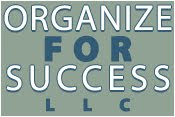I partner with busy professionals to help them efficiently and effectively use their available resources for increasing productivity and sharpening their business organization. Throughout the process, I find myself utilizing several organizing- and productivity-focused mantras. Often, these mantras are catchy phrases to stick in their heads as a reminder of what habits need developing. Here are 10 of my most frequently used mantras:
1. “A place for everything and everything in its place”… Once something has a designated home, it is more likely to return to that home after each and every use. Further, when you know where things belong, you can avoid procrastination related to putting things away, especially as new items enter your space that are related to what you already have.
2. “Keep like with like”… When similar or related items are grouped near each other, it makes finding items needed much simpler for yourself as well as others using the same space. For example, store the tape, scissors and stapler in one drawer together.
3. “Location, location, location”… Frequently used items should be kept most easily accessible and closest to where you are usually working. For example, the items you use daily can be kept on your desktop or the top drawer of your desk. Then, items should be stored increasingly further from you as they are used less and less often. What you reference only annually or very rarely could be in a different room or, even, in a different building. Likewise, items should be stored near where they will be used in order to save time and make it easier to locate what’s needed when it’s needed; for example, keep printer paper near the printer.
4. “Horizontal is hidden while vertical is visible”… Whether it’s in a file drawer, a desktop file organizer or organizers designed to hang on the wall, it’s easier to see the contents when they are stored vertically. Alternatively, when items are stored horizontally, the items on top hide what items are further below, making it more difficult to quickly find what you need. Save time searching and make it easier to see what is where by using vertical storage solutions.
5. “Don’t pile it; file it”… Rather than piling a paper in your To File tray, just file each sheet of paper as you get it, thereby never having to schedule a mass filing session again.
6. “Minimize paper clutter”… Since it’s easier to locate what’s needed from electronic documents than paper files, when you must keep the contents of a paper document, scan whatever you can. Options like Doxie Go, Fujitsu ScanSnap and Neat make it easy to convert your paper to electronic. Likewise, limit unnecessary incoming paper by stopping junk mail before it arrives; eliminate unwanted mail with catalogchoice.org, greendimes.com, dmachoice.org, PaperKarma stopthejunkmail.com or 41pounds.org.
7. “Utilize the power of one”… While many say that one is a lonely number, I believe that one is extremely powerful for enhancing one’s productivity. It’s important for each professional to have one calendar for both work and personal items, one running tasks list that funnels into one daily to-do list for each day, one “data dump” that enables our brains to think instead of remember everything, one address book to better maintain all our contacts’ information and one weekly strategy session, dedicating time each week to create the next week’s game plan. With one of each, we’re less likely to duplicate or have anything slip through the cracks.
8. “Done is better than perfect”… Stop procrastinating and start moving forward on your existing projects. If a task can be done in 5 minutes or less, just do it; if a task will take longer, get started. You might be surprised by how much you get done when you simply start working on it; plus, when you allow yourself to just do rather than striving for perfection, you can accomplish so much, leading to greater productivity, and you can always tweak your work later.
9. “Neat is not the same as organized”… While neat is defined as “in a pleasingly orderly and clean condition”, organized is actually defined as “structured and systematized”. In other words, while something that is neat will look attractive, it is only be implementing organization that the environment becomes another tool in your toolbox, better empowering you to quickly find what you need when you need it and to get more done in less time.
10. “Plan your work and work your plan”… Every action item that is assigned a time during which it can be addressed is more likely to be completed. If we wait for that free time in which we envision completing said task, that task might never move from “to-do” to “done”. While distractions and unplanned issues might arise, if you start the week with a game plan, you can more easily tweak each day to make sure all tasks and appointments get resolved.
Do you currently utilize any of these mantras? Are there any other mantras that you find helpful in your efforts to be more productive and more organized?
Subscribe to:
Post Comments (Atom)



No comments:
Post a Comment